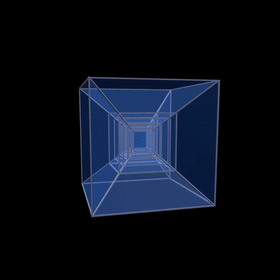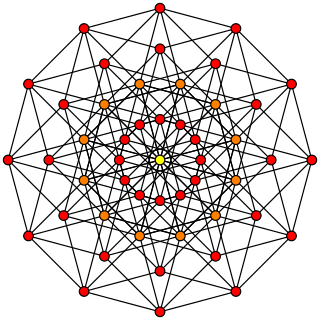Top Qs
Timeline
Chat
Perspective
6-cube
6-dimensional hypercube From Wikipedia, the free encyclopedia
Remove ads
In geometry, a 6-cube is a six-dimensional hypercube with 64 vertices, 192 edges, 240 square faces, 160 cubic cells, 60 tesseract 4-faces, and 12 5-cube 5-faces.
It has Schläfli symbol {4,34}, being composed of 3 5-cubes around each 4-face. It can be called a hexeract, a portmanteau of tesseract (the 4-cube) with hex for six (dimensions) in Greek. It can also be called a regular dodeca-6-tope or dodecapeton, being a 6-dimensional polytope constructed from 12 regular facets.
Remove ads
Related polytopes
It is a part of an infinite family of polytopes, called hypercubes. The dual of a 6-cube can be called a 6-orthoplex, and is a part of the infinite family of cross-polytopes. It is composed of various 5-cubes, at perpendicular angles on the u-axis, forming coordinates (x,y,z,w,v,u).[1][2]
Applying an alternation operation, deleting alternating vertices of the 6-cube, creates another uniform polytope, called a 6-demicube, (part of an infinite family called demihypercubes), which has 12 5-demicube and 32 5-simplex facets.
Remove ads
As a configuration
Summarize
Perspective
This configuration matrix represents the 6-cube. The rows and columns correspond to vertices, edges, faces, cells, 4-faces and 5-faces. The diagonal numbers say how many of each element occur in the whole 6-cube. The nondiagonal numbers say how many of the column's element occur in or at the row's element.[3][4]
Remove ads
Cartesian coordinates
Cartesian coordinates for the vertices of a 6-cube centered at the origin and edge length 2 are
- (±1,±1,±1,±1,±1,±1)
while the interior of the same consists of all points (x0, x1, x2, x3, x4, x5) with −1 < xi < 1.
Construction
There are three Coxeter groups associated with the 6-cube, one regular, with the C6 or [4,3,3,3,3] Coxeter group, and a half symmetry (D6) or [33,1,1] Coxeter group. The lowest symmetry construction is based on hyperrectangles or proprisms, cartesian products of lower dimensional hypercubes.
Remove ads
Projections
| 3D Projections | |
6-cube 6D simple rotation through 2Pi with 6D perspective projection to 3D. |
 6-cube quasicrystal structure orthographically projected to 3D using the golden ratio. |
 A 3D perspective projection of a hexeract undergoing a triple rotation about the X-W1, Y-W2 and Z-W3 orthogonal planes. | |
Remove ads
Related polytopes
Summarize
Perspective
The 64 vertices of a 6-cube also represent a regular skew 4-polytope {4,3,4 | 4}. Its net can be seen as a 4×4×4 matrix of 64 cubes, a periodic subset of the cubic honeycomb, {4,3,4}, in 3-dimensions. It has 192 edges, and 192 square faces. Opposite faces fold together into a 4-cycle. Each fold direction adds 1 dimension, raising it into 6-space.
The 6-cube is 6th in a series of hypercube:
 |
 |
 |
 |
 |
 |
 |
 |
 |
 |
| Line segment | Square | Cube | 4-cube | 5-cube | 6-cube | 7-cube | 8-cube | 9-cube | 10-cube |
This polytope is one of 63 uniform 6-polytopes generated from the B6 Coxeter plane, including the regular 6-cube or 6-orthoplex.
Remove ads
References
External links
Wikiwand - on
Seamless Wikipedia browsing. On steroids.
Remove ads









































































